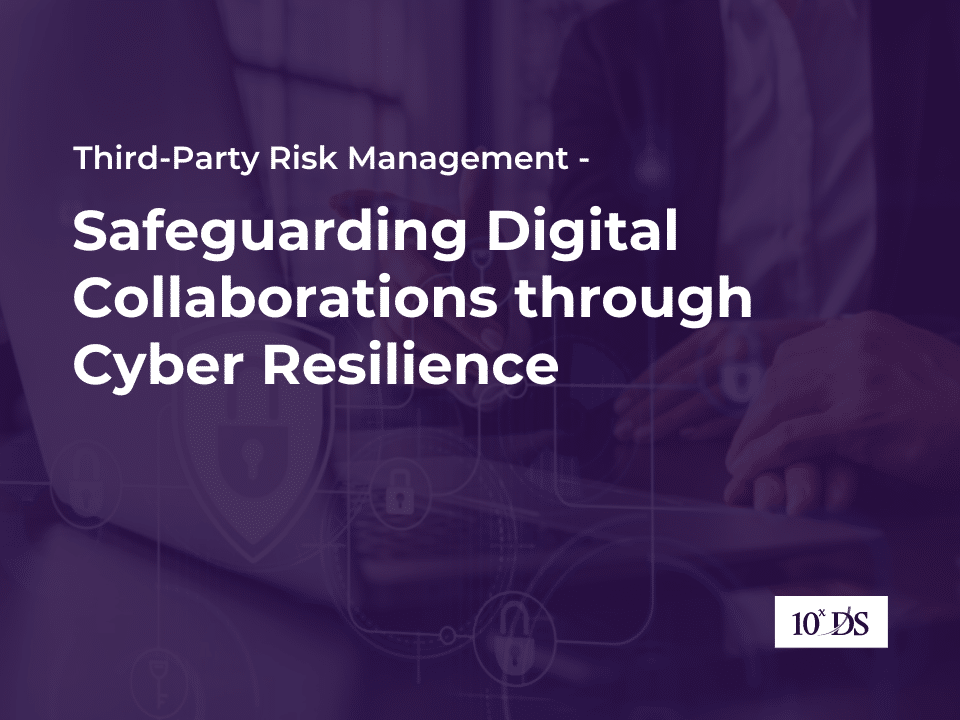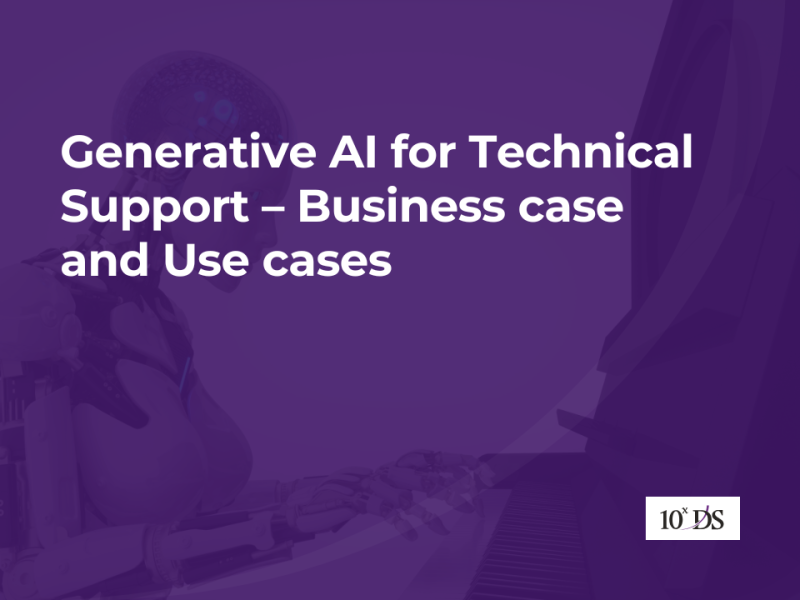
Third-Party Risk Management – Safeguarding Digital Collaborations through Cyber Resilience
The interconnected nature of modern business environments means that organizations often share data and resources with external parties to enhance efficiency and effectiveness. However, this collaboration also introduces new challenges, as the security posture of third parties may differ from the organization’s own standards. The potential cybersecurity threats and vulnerabilities that arise from the relationships and interactions with external entities, such as vendors, suppliers, contractors, or partners, who have access to an organization’s systems, data, or networks are referred as Third-party cyber risk. When an organization relies on third-party services, it introduces a level of dependency that can expose it to various cyber risks. These risks can include data breaches, unauthorized access, and other security incidents that may impact the confidentiality, integrity, or availability of sensitive information.
- Lack of visibility and control over the third-party’s security posture, policies, and practices. An organization may not have sufficient information or oversight on how the third-party manages its own cybersecurity, such as what security standards, frameworks, or certifications it follows, what security controls or tools it uses, or how it handles incidents or vulnerabilities.
- Inadequate or outdated contracts or agreements that do not specify the roles, responsibilities, and expectations of both parties regarding cybersecurity. An organization may not have clear or enforceable clauses that define the scope, frequency, and method of security assessments, audits, or reporting, the level of access or data sharing, the liability or indemnification in case of a breach, or the remediation or termination procedures.
- Weak or compromised credentials, access rights, or encryption keys that allow unauthorized or malicious access to the organization’s systems or data. An organization may not have implemented or enforced strong authentication, authorization, or encryption mechanisms for the third-party, such as multifactor authentication, role-based access control, or encryption at rest and in transit.
- Malicious or negligent insiders within the third-party that intentionally or unintentionally compromise the organization’s security. An organization may not have visibility or control over the background checks, training, or monitoring of the third-party’s employees, contractors, or subcontractors, who may have malicious intent, personal or financial motives, or human errors that lead to security breaches.
- Supply chain complexity and interdependency that increase the attack surface and the potential impact of a breach. An organization may not have a comprehensive or accurate inventory of all the third parties it works with, or the fourth parties or beyond that the third parties rely on. This creates a chain of trust and risk that can be exploited by attackers who target the weakest link or the most critical node.
- Third-party cyber risk management involves assessing and mitigating these risks through strategies such as comprehensive assessments of third-party vendors, continuous monitoring of their activities, and the establishment of clear contractual security agreements.
In summary, third-party cyber risk is the potential exposure to cybersecurity threats and vulnerabilities that arise from the relationships and connections with external entities, emphasizing the importance of implementing proactive measures to secure these relationships and protect sensitive information. Some of the recent supply chain attacks that have made headlines are:
The MoveIt attack exploited a flaw in the MoveIt managed file transfer service, which is used by many organizations to securely transfer sensitive files. The attack began on May 27, 2023 and used a zero-day vulnerability that allowed the hackers to inject SQL commands and access the databases of MoveIt customers. The attackers then used a custom web shell called LemurLoot to steal files from the affected servers, including Microsoft Azure Storage Blob information. The stolen files contained personal and confidential data of millions of people, such as names, dates of birth, social security numbers, driver’s licenses, banking and payment information, and more.
The SolarWinds attack, which was attributed to a Russian state-sponsored hacking group known as APT29 or Cozy Bear. The attackers inserted a backdoor into the software updates of SolarWinds Orion, a popular network management tool used by thousands of organizations worldwide, including government agencies, Fortune 500 companies, and critical infrastructure providers. The backdoor allowed the attackers to access the networks of the affected organizations and conduct espionage and data theft.
The CodeCov attack, which involved a breach of CodeCov, a software testing platform that provides code coverage analysis and reports. The attackers tampered with a script that CodeCov customers use to upload their code coverage reports to the platform. The modified script enabled the attackers to collect sensitive information from the customers’ environments, such as credentials, tokens, keys, and API endpoints. The attackers then used this information to access the customers’ internal systems and repositories.
The Kaseya attack, which was carried out by a ransomware group known as REvil or Sodinokibi. The attackers exploited a zero-day vulnerability in Kaseya VSA, a remote monitoring and management software used by managed service providers (MSPs) and their clients. The attackers used the vulnerability to deliver ransomware to the MSPs and their clients, encrypting their files and demanding payment for decryption. The attack affected more than 1,500 organizations across 17 countries, including schools, hospitals, and supermarkets.
Supply chain attacks pose a serious threat to the security and resilience of organizations, as they can bypass traditional defenses and cause widespread damage. Therefore, it is important for organizations to adopt a holistic approach to supply chain security. Third-party cyber risk management involves assessing and mitigating these risks through strategies such as assessing the risks of their vendors, implementing best practices for software development and deployment, and monitoring their systems and networks for any signs of compromise.
Comprehensive Assessment
Conducting a comprehensive assessment of third-party cyber risk involves meticulous planning and execution. Start by clearly defining the scope of your assessment, and identifying all third-party vendors that have access to your organization’s sensitive data or systems. Develop a detailed questionnaire to gather information about the vendor’s cybersecurity policies, procedures, and infrastructure. Follow up with interviews to gain deeper insights into their security practices. Once the data is collected, establish a risk scoring system to quantify and prioritize the identified risks. This risk scoring helps in focusing resources on addressing the most critical vulnerabilities and potential threats. Regularly update the assessment to adapt to changes in the vendor’s environment, ensuring an ongoing and dynamic understanding of third-party cyber risk.
Continuous Monitoring
Implementing continuous monitoring is essential to detect and respond to potential risks in real time. Utilize automated tools such as intrusion detection systems, security information and event management (SIEM) solutions, and vulnerability scanners. Configure these tools to generate real-time alerts for any suspicious activities, allowing for prompt investigation and response. Regularly audit and validate the effectiveness of the monitoring tools to ensure they are functioning as intended. Continuous monitoring provides a proactive approach to cybersecurity, allowing organizations to stay ahead of evolving threats and vulnerabilities by identifying and mitigating risks as soon as they arise.
Contractual Security Agreements
Strengthening your security agreements with third-party vendors involves clear communication and stringent expectations. Clearly articulate cybersecurity requirements in contractual agreements, specifying the security measures vendors must implement and the standards they need to adhere to. Define consequences for non-compliance, such as penalties, termination of the contract, or other appropriate measures. Include provisions for regular audits of the vendor’s security practices, ensuring ongoing compliance. Require vendors to provide reports on their cybersecurity measures, allowing for verification and transparency. Contractual security agreements create a legal framework that holds vendors accountable for maintaining a high level of cybersecurity, fostering a secure and trustworthy partnership.
Incident Response Planning
Collaborative incident response planning is crucial for minimizing the impact of security incidents. Work closely with third-party vendors to develop a comprehensive incident response plan. Clearly define roles and responsibilities for both parties, ensuring a coordinated and efficient response to security breaches. Conduct simulated drills or tabletop exercises to test the effectiveness of the incident response plan, identifying areas for improvement. Establish clear communication protocols, including points of contact and escalation procedures. Effective communication is essential during a security incident to ensure all stakeholders are informed and the response is well-coordinated. Collaborative incident response planning not only prepares organizations for potential threats but also strengthens the overall cybersecurity posture of both parties involved.
Stay Informed and Educated
Remaining informed and educated about cybersecurity is an ongoing process that requires dedication and continuous learning. Stay updated on the latest cybersecurity threats, vulnerabilities, and best practices through industry publications, conferences, and online resources. Provide ongoing cybersecurity training for your team, covering topics such as social engineering tactics, emerging malware, and evolving threats. Engage with cybersecurity communities to share knowledge, insights, and experiences. Networking with professionals in the field can provide valuable perspectives and early warnings about emerging threats. By fostering a culture of continuous learning and community engagement, organizations can stay ahead of the ever-evolving landscape of cybersecurity, adapting and enhancing their defenses against emerging threats.
In conclusion, cultivating cyber resilience in the face of third-party risks is not merely a proactive approach; it’s an indispensable necessity in the dynamic landscape of interconnected digital ecosystems. By embracing comprehensive assessments, continuous monitoring, robust contractual agreements, collaborative incident response planning, and a commitment to staying informed, organizations can fortify their defenses against potential cyber threats originating from external entities. The ability to adapt, anticipate, and swiftly respond to emerging risks is paramount, ensuring that the delicate balance between collaboration and security is maintained. Ultimately, cyber resilience is the linchpin in securing the integrity, confidentiality, and availability of critical assets, forging a resilient and secure path forward in an ever-evolving cyber landscape.
Talk to our Experts to learn more


